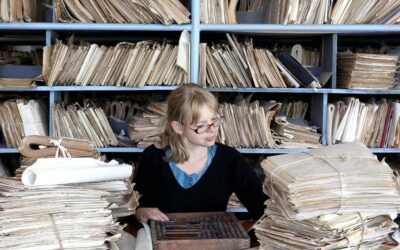The Current State of Description for Archives

Margot Note
In July 1945, Atlantic Monthly published “As We May Think,” by army scientist Vannevar Bush, an essay that had an immense influence on the history of computing. Bush was concerned about the explosion of information without a means to quickly retrieve data.
The article described a device called a Memex, an intuitive, associative retrieval system designed to supplement memory. He envisioned a desk with screens that would allow users to view documents, add notes, and create associations through a body of work.
The Memex was a conceptual ancestor to electronically linked materials and, ultimately, the Internet. Bush’s ideas were expanded by Theodor Nelson who, in 1961, coined hypertext and hypermedia to describe the environment where text, images, and video could be digitally interconnected.
The popularity of the Internet and the improvement of technology allowed for online access to archival holdings, as well as created an impetus for many institutions to provide more in-depth descriptive information for their holdings. Archival collections are among the least accessible resources available because of their size, organization, physical fragility, and basic cataloging. Many collections consist of large groups of related materials that share one or more significant characteristics, such as source, subject, or medium.
Description for Archives, Libraries, and Museums
Archival description has sought to combine traditional library and archival practice with the more focused descriptive practices found in the museum and visual resources communities. Libraries catalog published, non-unique items, such as books and serials, which are published with multiple copies and a list of descriptors, such as author, title, publisher, and year, which appear printed on the book and leave little room for subjective opinion. As soon as one library catalogs a book, any library can copy its cataloging and apply it to its holdings. Catalogers in libraries use standards such as MARC (Machine-Readable Cataloging) and AACR2 (Anglo-American Cataloging Rules, Second Edition) with LCSH (Library of Congress Subject Headings) descriptors. AACR2 and MARC are heavily biased toward printed documents, which is not surprising given that they matured before digital assets were commonplace. Libraries have only recently begun to catalog individual items in their collections but have typically not described the collections that contain them.
Subjective Descriptive Methods
Museums, on the other hand, have acquired expertise in describing their unique holdings, usually describing the collection first and the individual items secondly, grouping items together by artist, media, provenance, or historical period. Description often includes style or genre, history and use of the item, and preservation details. Much of the information registered when cataloging an artwork at one museum cannot be copied and applied to another work held by another institution. The attributes of the items and their most basic descriptors are often speculative or subjective. For example, artist name, year of production, and place of origin do not appear alongside the work at its inception as with a book, but rather require curators to research them and come to their own conclusions. This subjective descriptive method leads to different information on the same object. Practices also vary because of the diverse nature of individual museums and their collections.
Archival Description
Archives create detailed descriptions of unique materials or their representations, usually original unpublished material or primary sources, which can be expressed as both item- and collection-level records. In archival practice, description expands upon information gleaned during appraisal and arrangement, which produces preliminary descriptive forms, such as container lists, summarizes the context and content of archival materials at multiple levels, and adds usage restrictions and access points for creators and subjects. Archives catalog their materials using subjective descriptive texts and individual cataloging fields.
Challenges of Image Description
Archival collections often do not have a clearly defined or preexisting organizational structure, individual titles, or creator names by which they can be described. In the case of libraries and archives, it was a natural progression to use methods already developed to describe books and documents, to describe other assets. However, these bibliographic methods do not adequately address the unique characteristics of archival collections. No single description method has been developed that can meet the description needs of all archives, libraries, and museums—and their description differences make searching for materials across types of institutions challenging.
An Act of Translation
Cataloging archival materials can be idiosyncratic, knowledge-intensive, and time-consuming because the very characteristics that make these assets valuable also make them difficult to describe. Poor-quality records often exist because they are created by people who are not catalogers, are created based on local practice that does not facilitate interoperability, or are based on traditions that do not translate well for managing digital objects. Adding to that difficulty, description and retrieval is an act of translation, complicated by transforming concepts to words, particularly to specialized terms that might appear in an index or thesaurus, and mapping the terms of a mental model or natural-language query to controlled language—which is fundamentally different from the processes of subject cataloging of texts.
Even with the emergence of online catalogs, web-accessible collections, and improved information searching and navigation, access to archival collections has remained limited due to a lack of standardized description and integrated modes of access. We need more tools to automate processes for metadata creation, revision, and harvesting; this would provide benefits regarding consistency, interoperability, and long-term viability of meaningful metadata. The initial expense and difficulty of creating high-quality metadata is compounded by the need for constant revision to correct mistakes and incorporate changes to subject terms, taxonomies, and controlled vocabularies—along with changes to meet continually evolving patron research needs.
With each new project we complete as archivists, we move ever closer to presenting our users with collections they can access much more easily. The effort expended to describe our historical holdings is well worth the effort.

Margot Note
Stan writes regularly for Lucidea’s Think Clearly blog. Subscribe to ensure you never miss a post with engaging information for KM practitioners and special librarians! Learn about Lucidea’s Presto, SydneyDigital, and GeniePlus software with unrivaled KM capabilities that enable successful knowledge curation and sharing.
Similar Posts
Principles of Archival Preservation: Agents of Deterioration and Preservation Strategies
Explore the 5 key agents of deterioration and essential archival preservation strategies to safeguard your collections for future generations.
Creating Effective Archival Finding Aids: Tips for Writing Clear Descriptions
Clear concise archival descriptions improve accessibility support discoverability and enhance the research experience. In this article we’ll explore best practices for crafting finding aids that are both informative and engaging.
Balancing Collection- and
Item-Level Information in Archival Description
How much detail is enough when describing an archival collection? Finding the right balance between broad overviews and detailed item descriptions ensures accessibility research efficiency and proper context for archival materials.
Best Practices in Archival Description
Standards like ISAD(G) DACS and EAD guide archivists in creating clear consistent descriptions for easier access. Learn more about each of these frameworks and how they enhance visibility and research.





